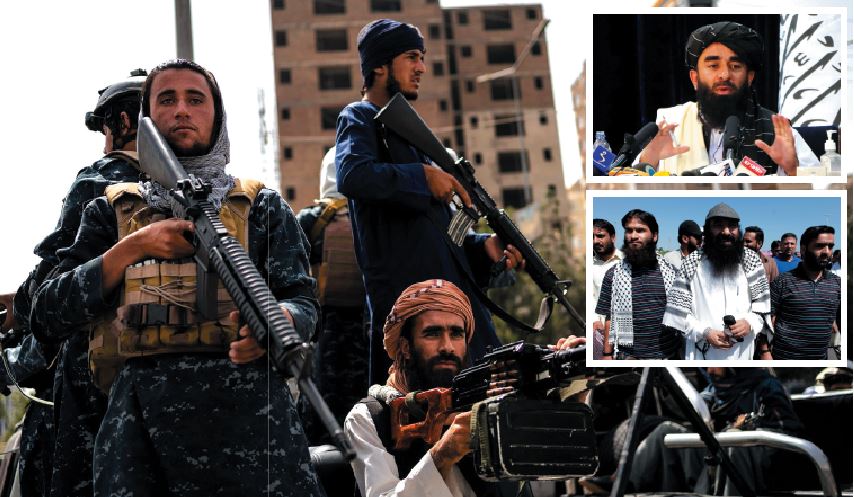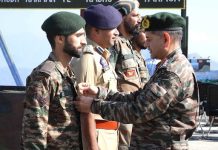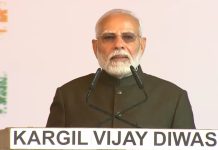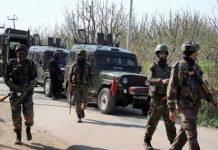
Back in saddle in Afghanistan, will Taliban turn its gaze on Kashmir? A report by Riyaz Wani
Ever since the Taliban captured Kabul on August 15, Kashmir has been in news as a place likely to be impacted by the far-reaching development. It is widely anticipated that a Taliban-ruled Afghanistan will give a fillip to otherwise waning armed struggle in the Valley. At the same time, many analysts reject the possibility of the Taliban getting involved in Kashmir. They argue that much has changed since the mid-nineties when the group was governing Kabul.
Among them is Pravin Sawhney, a former Indian army officer and the Editor of Force magazine who was recently on a visit to Kashmir. In a video analysis he shot on the banks of Dal lake, Sawhney discounted the possibility of the Taliban coming to India.
“(The possibility) that Lashkar and Jaish who are close to the Haqqani network and the Taliban will be sent here to fight by Pakistan, I don’t buy all this for the simple reason that times have changed,” he said.
However, he was quick to add that the proxy war will continue in Kashmir. “Pakistan has not downgraded proxy war in Kashmir. The proxy war will continue but right now their priority is stabilizing Afghanistan and looking at connectivity.”
But among the people who think that the Taliban takeover will have security implications for Kashmir is the senior BJP leader Ram Madhav, a former point man on Kashmir.
“Taliban has over 30K (30,000) mercenaries trained in Pak by ISI. In power in Kabul, Taliban leadership wl (will) now deploy them ‘elsewhere’ wid d (with the) help of mentor Pak. India shud (should) brace up for serious security challenges. Taliban may eventually consume Pak n China 2 (too), but the immediate threat is 4 (for) India,” Madhav tweeted soon after the Taliban walked into Kabul.
GEO-POLITICAL CONSTRAINTS
There are reasons to believe that the existing geopolitics will come in the way of using Taliban controlled Afghanistan as a staging post to intensify militancy in the Valley. The situation now is contrary to the nineties when the armed struggles across the world, more so in places inhabited by Muslims, were yet to be seamlessly branded as terrorist. Nor is now the world ready to countenance the use of the territory of one country by the armed groups against another. The ongoing oversight of Pakistan’s terror-financing role by the Financial Action Task Force, the global money laundering and terrorist financing watchdog, is clear proof of this.
This puts both Pakistan and the Taliban in a bind. Any effort to escalate the militancy in Kashmir with the help of the foreign militants including those from Afghanistan will be held against the two countries. It will also not be easily overlooked by Pakistan’s closest ally China which is apprehensive of the Taliban support for the separatist militants in Xiangyang. Nor by Iran or for that matter Russia which has otherwise chosen to engage with the Taliban and also have reasonably good relations with Pakistan.
On the other hand, India’s excellent relations with the United States, still the world’s No 1 superpower, and the wider west would enable New Delhi to mobilize the global opinion against Pakistan and Afghanistan under the Taliban, something the latter two would be chary of. The Taliban which currently craves global legitimacy, aid and recognition would be loathe to getting involved in other struggles. And this is also apparent considering the balanced noises it has made so far on Kashmir – albeit, the group has said it would raise the issue of Muslims of Kashmir like that of Muslims elsewhere.
Soon after taking control of Kabul, the Taliban also said that Kashmir was “an internal and bilateral issue”. Senior Taliban leader Anas Haqqani said in an interview to an Indian Television channel that Kashmir was being beyond its “jurisdiction”. Another leader of the outfit, Sher Mohammad Abbas Stanekzai said the Taliban wants economic and political ties with India.
But for now, no one in India or for that matter even in the world is ready to take the Taliban statements at their face value. Things would become clear only as the Taliban settle down in power and begin engaging with the world, especially their neighbours.
As for Pakistan, being seen as responsible for any escalation in violence in Kashmir wouldn’t play well for it globally. More so, when the west sees it largely responsible for the Taliban win in Afghanistan and also too close to China for their comfort. The FATF sword continues to hang over Islamabad’s head. The FATF has been reluctant to move Pakistan out of the grey list seeking demonstrable action against the UN-designated terrorist leaders and the organisations like Lashkar-i-Toiba and Jaish-e-Mohammad. This makes it difficult for Pakistan to be seen supporting these outfits and using them in Kashmir.
Making things for Pakistan more problematic is that the US Secretary of State Antony Blinken, while testifying recently before Congress on the Taliban victory in Afghanistan, said his country will be reassessing its relationship with Pakistan in the coming weeks, and formulate what role Washington would want it to play in the future of Afghanistan. Blinken blamed Pakistan for hedging its bets constantly about the future of Afghanistan, and being involved in “harbouring members of the Taliban”.
So, Pakistan would be cautious not to alienate the US further at a time the country also needs international financial support for its ailing economy. Pakistan also doesn’t want to be seen as completely aligned with China but seeks to retain its old ties to the US, even if in their diluted form now.
“I don’t see any significant impact on Kashmir of the Taliban victory,” said noted security analyst Ajai Sahni. “If Pakistani or Afghani militants wanted to come and fight in Kashmir they didn’t need to wait for the Taliban to take power. Taliban rule in Afghanistan has thus no direct connection to jihad in Kashmir.”

FAVOURABLE CIRCUMSTANCES
That said, some analysts see it improbable that Pakistan wouldn’t use its newfound geopolitical advantage following the Taliban takeover to pursue its longstanding Kashmir goal. After all, it has once again got back its “strategic depth,” in Afghanistan. The Taliban government is regarded pro-Pakistan, so least accommodative of India, removing the fear in Islamabad of India trying to encircle it. The world including the US attributes the Taliban victory, in large part, to Pakistan’s support and harbouring of the outfit’s leadership – in addition to alleged help by Pakistan based Kashmir-focussed militant groups like Lashkar and Jaish. The Taliban victory is thus also a victory for Pakistan’s perceived strategy of not letting go of the Taliban during its resistance to American occupation. It is also a renewed source of inspiration for the jihadi groups to resume their mission in Kashmir, with or without Pakistan’s support.
Soon after the Taliban triumph, Hizbul Mujahideen supremo Syed Salahuddin in an audio statement said that he expected the Taliban to aid Kashmiris. He also expressed the confidence that a similar resistance in Kashmir would help end “occupation by India.” There has, however, been no statements from Jaish or Lashkar leaders so far. In fact, there has hardly been any statement from the leaders of these organizations since the last two years. Nor have the two outfits claimed responsibility for the attacks in Kashmir in this time frame.
Pakistan, under what is believed to be pressure from the FATF which has sought urgent action by Pakistan against the terror funding infrastructure and the entities involved, has cracked down on the leaders of Kashmir-centric militant groups like Lashkar and Jaish-e-Mohammad. Lashkar leaders like Hafiz Saeed and Zaki-ur-Rahman Lakhvi have been jailed. Similarly, Jaish chief Masood Azhar and Hizbul Mujahideen supremo Syed Salahuddin have become conspicuous by their absence from the scene, more so, the former.
On the contrary, Kashmir has witnessed the advent of two outfits with secular sounding names – The Resistance Front and the People’s Anti-Fascist Front – which the security agencies claim are fronts for Lashkar. The two outfits have carried out some low-profile attacks.
“Given the history of the past thirty years, it doesn’t take much time for the situation to change in Kashmir,” says Naseer Ahmad, author of Kashmir Pending. “A fillip in infiltration, supply of arms and some more spike in local recruitment in the militancy could shift the ground situation.”
But so far there are little signs that this is happening – albeit, there are some faint stirrings in the air. In a recent statement, General Officer Commanding (GoC) of the Army’s Srinagar-based 15 Corps or Chinar Corps, Lt Gen D P Pandey, said there has been no ceasefire violation along the Line of Control (LoC) in Kashmir since the reiteration of the agreement between the armies of India and Pakistan in February this year,
“The ceasefire violations have not increased. This year there has been none (ceasefire violation). At least in the Kashmir Valley, there has been zero,” the GoC told reporters on the sidelines of a function in Srinagar.
However, around the time Lt Gen Pandey made this statement, the security forces were engaged in a combing operation after detection of suspicious movement along the Line of Control (LoC) in Uri on the intervening night of September 18 and 19. The infiltration attempt was billed as the biggest this year, forcing the administration to snap the mobile and internet services. Later, the Army killed three militants in an encounter in North Kashmir’s Baramulla district.
Also, a recent media report quoting security forces pointed at a modest build-up of foreign militants in North Kashmir. The report quoted the latest data by the police, whereby 40 to 50 foreign militants are active in north Kashmir against just 11 local militants. However, the security agencies have not connected this build-up to the change in Afghanistan saying this was in the works over the last several months.
POST-ARTICLE 370 MILITANCY
Though militancy is the only form of resistance that has survived in Kashmir since the withdrawal of Article 370 that granted Jammu and Kashmir its semi-autonomous status under India’s constitution, it has also been at a low ebb. The militancy-related violence that Kashmir has witnessed over the last two years has largely been about militants losing their lives in encounters with the security forces.
A majority of the militants, most of them the locals, are concentrated in South Kashmir. Kashmiri youth now take up arms and train locally. Due to the fencing and massing of troops along the Line of Control, Kashmiri youth have stopped going to Pakistan for arms training. Often the local training involves little more than possession of a Kalashnikov or sometimes a mere pistol. This renders local militants inherently incapable of mounting a major attack on security forces. Their presence has largely a symbolic value. In encounters, they hardly put up a fight and are killed shortly after being tracked down. The violence in South Kashmir bears this out: Now rarely any soldier loses his life in firefights.
Last year, security forces had killed over 200 militants and so far this year around 163 militants have been killed in various encounters. According to the existing figures, the number of militants in Kashmir continues to hover around 200, same as it was last year. This has been more or less the annual number of militants over the last five years. And there’s little hope there will be a marked decline in the near future. If anything, these figures show that the militancy in the Valley has gone nowhere following the revocation of Article 370. This despite the fact that the security forces have achieved greater success in the operations against militants in this period.
Going forward, there is little indication that the militancy would cease or at least abate to a point of insignificance. The simultaneous recruitment of the local youth in the militant ranks and the infiltration from across the border invariably replenishes the shortfall created by any deletion in the militant ranks due to killings.
As of now, there is little hope that the replenishment could be stopped. That too, even at a time when the infiltration has drastically declined, largely as a result of the February LoC truce between India and Pakistan as also attested to by the Srinagar-based 15 Corps chief Lt Gen Pandhe. In fact, since the advent of Burhan Wani around 2014-15, the militancy in Kashmir has largely been led by the local youth. And if the militants from Pakistan or for that matter from Afghanistan were to join the fight as appears one of the probable outcomes of the Taliban takeover, it could transform the security landscape in the Valley.
And it is this potential transformation that has been a cause of some concern for the security agencies in the Valley – albeit, they have made it known that any foreign militant coming to Kashmir will meet the same fate as the local militants.
“I am not looking at questions on Taliban or foreign terrorists or local terrorists. For us, it has got nothing to do with the quality and quantity. If there is a gentleman who picks up a weapon, he will be neutralised either way by getting killed or by getting apprehended and if he comes and offers (to) surrender, we will take surrender,” Lt Gen Pande told reporters in Srinagar.
A FRAUGHT FUTURE
Would things change now? The opinion remains split over the possibility of this happening. And there are valid arguments for both points of view. Significantly, however, security forces in J&K seem on the side of those who see some spillover of Afghanistan violence in Kashmir but are ready for any turn the situation takes. The GOC 15 Corps and earlier Inspector General of Police Kashmir Vijay Kumar have made it clear that any Taliban fallout on Kashmir isn’t a matter of any serious concern for them.
“Speaking as a police officer whichever terrorist comes here, it is my job to generate input and neutralise him, as well as the threat, in an operation with the Army,” Inspector General of Police, Kashmir, Vijay Kumar told reporters at a recent event of the Army’s Victor Force in Awantipora area of Pulwama district.
“We will handle all the challenges in a professional manner and we are totally alert”, The IG added.
But one thing that almost all experts agree on is that the militancy will continue in J&K. “What remains to be seen is whether it follows the pattern of the last decade with a constant figure of around 200 militants keeping the show going or whether Pakistan chooses to bolster it and give it teeth,” said a police officer on the condition of anonymity. “But this time around this won’t make much of a difference in Kashmir as the security dominance is now such that the foreign jihadis will find no place to hide.”
Taliban’s fallout in Kashmir has been a subject of debate in the local press too. A local daily, Kashmir Observer, in a recent editorial, played it safe by saying that the Taliban’s return to power does not mean that the nineties will repeat in Kashmir, but at the same time, nothing could be ruled out.
“The way the situation in Afghanistan is shaping up, bears with some due exceptions an uncanny resemblance to the run up to the Soviet withdrawal,” the editorial read. “It is also true that it is now 2021 and not 1989. The situation could thus play out differently”.
TEHELKALETTERS@GMAIL.COM












